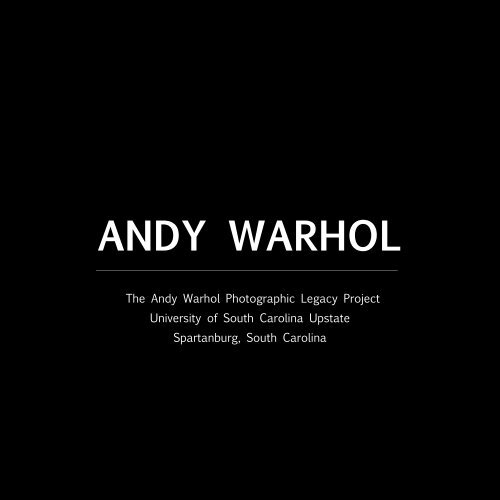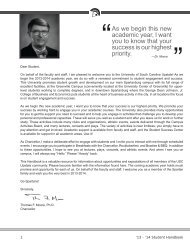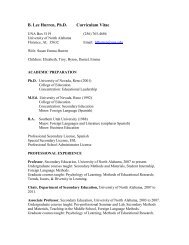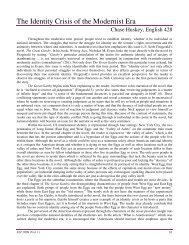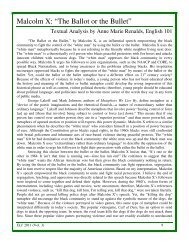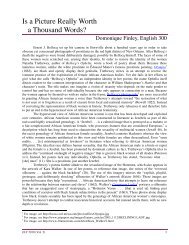The Andy Warhol Photographic - University of South Carolina Upstate
The Andy Warhol Photographic - University of South Carolina Upstate
The Andy Warhol Photographic - University of South Carolina Upstate
Create successful ePaper yourself
Turn your PDF publications into a flip-book with our unique Google optimized e-Paper software.
ANDY WARHOL<br />
<strong>The</strong> <strong>Andy</strong> <strong>Warhol</strong> <strong>Photographic</strong> Legacy Project<br />
<strong>University</strong> <strong>of</strong> <strong>South</strong> <strong>Carolina</strong> <strong>Upstate</strong><br />
Spartanburg, <strong>South</strong> <strong>Carolina</strong>
ANDY WARHOL<br />
<strong>University</strong> <strong>of</strong> <strong>South</strong> <strong>Carolina</strong> <strong>Upstate</strong> Collection<br />
Gift <strong>of</strong> the <strong>Andy</strong> <strong>Warhol</strong> Foundation
(Fig. 1) Lauren Hutton, April 23, 1982, Black and White print, 8X10”, Collection USC <strong>Upstate</strong>.
Contents<br />
Introduction<br />
Special Thanks to<br />
Spartanburg County Council<br />
and<br />
<strong>University</strong> <strong>of</strong> <strong>South</strong> <strong>Carolina</strong> <strong>Upstate</strong> Foundation<br />
for Support <strong>of</strong> this Project.<br />
Jane Allen Nodine<br />
Essays<br />
<strong>Andy</strong> <strong>Warhol</strong>: In the Vernacular, Catherine Zuromskis, Ph.D.<br />
<strong>Warhol</strong> In and Out <strong>of</strong> the Still Life Tradition, Rachel Snow, Ph.D.<br />
Portrait as Process, Heather Shockey<br />
Online catalogue available at: www.uscupstate.edu/warhol/<br />
All images have been reproduced with integrity to the original photographs created by <strong>Andy</strong> <strong>Warhol</strong>, including full-frames,<br />
flaws, color and printing errors.<br />
Biographies<br />
List <strong>of</strong> Images (Figs. 1– 44)<br />
All rights reserved by USC <strong>Upstate</strong> © 2010. No part <strong>of</strong> this material may be reproduced without the explicit permission<br />
<strong>of</strong> the Curtis R. Harley Gallery and <strong>University</strong> <strong>of</strong> <strong>South</strong> <strong>Carolina</strong> <strong>Upstate</strong> Foundation.<br />
Inquiries concerning loans or research <strong>of</strong> the collection should be directed to Jane Allen Nodine, Director <strong>of</strong> the Harley<br />
Gallery. email: jnodine@uscupstate.edu or phone: 864.503.5838.<br />
Catalogue design by Jane Allen Nodine.<br />
4<br />
5
Sifting through mail one day in February 2007, I sorted the usual suspects to a discard<br />
pile as I checked emails and listened to voice messages. Some distraction steered me away from<br />
the <strong>of</strong>fice and the discards stayed on my desk for a few days, or it may have been weeks. My<br />
<strong>of</strong>fice becomes a maze <strong>of</strong> papers, equipment and supplies after the first week into the semester<br />
and I keep faith my colleagues won’t perform an intervention for hoarding. At some point the<br />
discard pile resurfaced and a return address for the <strong>Andy</strong> <strong>Warhol</strong> Foundation nagged for my<br />
attention. Before throwing it directly into the trash I opened the letter to see what sort <strong>of</strong> solicitation<br />
was enclosed. Skimming the first few lines I got to the middle <strong>of</strong> the letter and realized<br />
it was actually directed to me, Jane Nodine, director <strong>of</strong> the Art Gallery. <strong>The</strong> content <strong>of</strong> the<br />
letter was <strong>of</strong>fering a gift <strong>of</strong> original <strong>Andy</strong> <strong>Warhol</strong> photographs, if the <strong>University</strong> <strong>of</strong> <strong>South</strong> <strong>Carolina</strong><br />
<strong>Upstate</strong> met criteria required by the Foundation. I re-read the letter several times; quite sure I<br />
had overlooked some bit <strong>of</strong> fine-print information, and finally decided it might be authentic. What<br />
else to do but Google the names and places, just in case. <strong>The</strong> pages appeared for the <strong>Andy</strong><br />
<strong>Warhol</strong> Foundation; the names <strong>of</strong> the director and the curator <strong>of</strong> photography were all listed, as<br />
were details <strong>of</strong> the <strong>Andy</strong> <strong>Warhol</strong> <strong>Photographic</strong> Legacy Program that honors the 20th anniversary<br />
<strong>of</strong> the <strong>Warhol</strong> Foundation.<br />
<strong>The</strong> function <strong>of</strong> the Legacy Program is to make substantial gifts <strong>of</strong> <strong>Warhol</strong> photographic<br />
works to university and college museums, galleries, and art collections across the United<br />
States. <strong>The</strong> mission <strong>of</strong> the project is to provide greater access to <strong>Warhol</strong>’s artwork and process<br />
and enable a wide range <strong>of</strong> people from communities across the country to view and study<br />
this important yet relatively unknown body <strong>of</strong> <strong>Warhol</strong>’s work. After exchanging numerous emails<br />
and documentation <strong>of</strong> the <strong>University</strong>’s non-pr<strong>of</strong>it status, I was contacted by the Foundation in<br />
May and informed that USC <strong>Upstate</strong> had been approved to receive over 150 <strong>of</strong> the images<br />
from the Foundation’s exorbitant collection <strong>of</strong> 28,543 original <strong>Warhol</strong> photographs valued at<br />
twenty-eight million dollars.<br />
(Fig. 2) Male Model, 1982, Black and White Print, 8X10”, Collection USC <strong>Upstate</strong>.<br />
Acquiring 152 original photographs by an artist <strong>of</strong> <strong>Andy</strong> <strong>Warhol</strong>’s stature is an exciting<br />
experience and yet a daunting responsibility. While the <strong>University</strong> has had an art gallery<br />
for over thirty years and a number <strong>of</strong> works in their permanent collection, our dealings have<br />
primarily included regional and a few nationally recognized artists. So this seemed like an exciting<br />
opportunity with the addition <strong>of</strong> an interesting journey. In accepting the gift, the <strong>University</strong>,<br />
which at that point was me, agreed to promote and make public the collection through exhibitions<br />
and research venues.<br />
6<br />
7
In March <strong>of</strong> 2008, Jenny Moore, curator for the <strong>Photographic</strong> Legacy Program, notified<br />
me that shipment <strong>of</strong> the photographs she had selected for USC <strong>Upstate</strong>, from the mass <strong>of</strong><br />
photographs managed by the Foundation would be made in April. Near the end <strong>of</strong> the month I<br />
received a curated selection <strong>of</strong> I52 mostly unseen original color Polaroid and black and white<br />
photographs which include a mix <strong>of</strong> subjects and styles.<br />
As viewers browse our collection <strong>of</strong> photographs taken by <strong>Warhol</strong> during the seventies<br />
and eighties, they may question the significance <strong>of</strong> a single image such as a group <strong>of</strong> eggs on<br />
a dark background, an overhead view <strong>of</strong> a parking lot, miscellaneous cafeteria food, or endless<br />
snapshots <strong>of</strong> mostly anonymous figures. And viewers would be justified to wonder about them<br />
as single images torn from context, because the solo photographs hold modest meaning and<br />
alone are not the work <strong>of</strong> art. <strong>The</strong> significance <strong>of</strong> these images lies in the body, or collection,<br />
<strong>of</strong> photographs and in the viewer’s chance to see into the mind <strong>of</strong> the artist: a glimpse, be it<br />
ever so slight, into the creative process <strong>of</strong> Andrew <strong>Warhol</strong>a, better known as <strong>Andy</strong> <strong>Warhol</strong>.<br />
several scholarly essays to include with the intent to broaden points <strong>of</strong> view and further expand<br />
opinions <strong>of</strong> this iconic artist and his work.<br />
Generous thanks are due Rachel Snow, Ph.D. art historian, colleague and friend, for her<br />
contributions to seeing this project accomplished in scholarly form, and to Dr. Snow’s student<br />
intern, Heather Shockey, an astute researcher who worked with Dr. Snow during countless hours<br />
they dedicated to this project. Special thanks to Catherine Zuromskis, <strong>of</strong> the <strong>University</strong> <strong>of</strong> New<br />
Mexico, for her contribution to the catalogue.<br />
August 2010<br />
Jane Allen Nodine<br />
Curtis R. Harley Gallery<br />
<strong>University</strong> <strong>of</strong> <strong>South</strong> <strong>Carolina</strong> <strong>Upstate</strong><br />
<strong>The</strong> Polaroid portrait photographs served as reference material for <strong>Warhol</strong> as he manufactured<br />
colorful silk-screen portraits for commissions during these years and allowed him to<br />
support a rather comfortable and <strong>of</strong>ten extravagant lifestyle. But all <strong>of</strong> the photographs also<br />
served as documentation, the documentation <strong>of</strong> <strong>Andy</strong> <strong>Warhol</strong>’s life, his day-to-day activities, his<br />
collections and visual record <strong>of</strong> things he saw, people he met, food he ate, and things he did.<br />
It was his precursor to Facebook, Twitter or MySpace. Or maybe <strong>Warhol</strong>’s most noted quote,<br />
“In the future, everyone will be world-famous for 15 minutes,” (now immortalized as the phrase,<br />
“Fifteen Minutes <strong>of</strong> Fame”) gave rise to the social networking blogs we now refer to as status<br />
updates.<br />
Looking back, this whole process reminds me a bit <strong>of</strong> watching a dog chase a car, and<br />
wondering what he would do if he caught it. I was as surprised to receive these photographs as<br />
that dog would have been to find himself in possession <strong>of</strong> an automobile. Almost three years<br />
have passed since the invitation letter arrived from the <strong>Warhol</strong> Foundation, and I am grateful for<br />
the opportunity to write the introduction for the catalogue that will accompany the USC <strong>Upstate</strong><br />
collection <strong>of</strong> photographs by <strong>Andy</strong> <strong>Warhol</strong>. <strong>The</strong> <strong>University</strong> is pleased to <strong>of</strong>fer this modest group<br />
<strong>of</strong> original photographs as a way to further inform, generate discussion, and give explanation<br />
about the works and influences <strong>of</strong> <strong>Andy</strong> <strong>Warhol</strong>. In support <strong>of</strong> the collection I have selected<br />
8<br />
9
<strong>Andy</strong> <strong>Warhol</strong>: In the Vernacular<br />
Catherine Zuromskis<br />
Few photographers have been as astoundingly prolific as <strong>Andy</strong> <strong>Warhol</strong>. A devotee <strong>of</strong><br />
inexpensive and easy to use photographic technologies, <strong>Warhol</strong> was seemingly never without<br />
his one <strong>of</strong> his Polaroid “Big Shots” cameras or a small, portable 35mm point-and-shoot. <strong>Warhol</strong><br />
supported himself throughout the 1970s with lucrative silkscreen portrait commissions all<br />
produced from original Polaroids. He also obsessively documented friends, trips, celebrity parties,<br />
and daily life with his camera. <strong>Warhol</strong> published his photographs in books, stitched them<br />
together into large serial artworks, and squirreled them away in his monthly “time capsules.”<br />
According to one <strong>of</strong>t repeated account by Bob Colacello, editor <strong>of</strong> <strong>Warhol</strong>’s Interview magazine<br />
throughout the 1970s and early 1980s, during the last decade <strong>of</strong> his life <strong>Warhol</strong> shot an<br />
estimated one roll <strong>of</strong> film per day; “at 36 frames per roll,” Colacello estimates, “it added up<br />
to over 13,000 images a year, and over 150,000 images in the 12 years between 1976 and<br />
1987.” 1 It is this voracious photographic habit that produced the selection <strong>of</strong> over 28,500<br />
photographs donated to more than 180 college and university art collections by the <strong>Andy</strong><br />
<strong>Warhol</strong> Foundation through the <strong>Andy</strong> <strong>Warhol</strong> <strong>Photographic</strong> Legacy program—their sheer number<br />
so staggering they seem to require parceling out into bite size, comprehensible chunks. But<br />
even in these representative samplings, <strong>Warhol</strong>’s photographs seem to defy simple explanation.<br />
Perusing the assortment <strong>of</strong> photographs in this exhibition, one wonders what to make <strong>of</strong> the<br />
series <strong>of</strong> almost identical 3 ¼ X 4 ¼ inch Polaroid portraits <strong>of</strong> dramatically pale Nancy Nasher<br />
(the renowned art collector) (1979) (Fig. 3 – 6) gazing somberly and somewhat awkwardly over<br />
her bare white shoulder, or a decidedly blurry black-and-white 8 x 10 <strong>of</strong> a station wagon (Fig.<br />
7) parked on a dirt road, its rear door open to reveal a pile <strong>of</strong> luggage, or a glaring blackand-white<br />
print <strong>of</strong> an unidentified muscular young man in a polo shirt and khakis (Fig. 8) drink<br />
in hand (at a party perhaps, though <strong>Warhol</strong>’s flash has completely obliterated any trace <strong>of</strong> the<br />
background) looking askance at someone beyond the edge <strong>of</strong> the frame. What do these<br />
Clockwise from top left: (Figs. 3 – 6) Nancy N. Nasher, 5/1979, Polacolor Type 108, Collection USC <strong>Upstate</strong>.<br />
1 Bob Colacello, “Paparazziism: Or How <strong>Andy</strong> <strong>Warhol</strong> Became a Real Photographer,” Social Disease: Photographs<br />
’76 – ‘79, Karl Steinorth and Thomas Buchsteiner, eds. (Tübingen: Institut für Kulturaustausch, 1992), 16.<br />
10<br />
11
photographs tell us about one <strong>of</strong> the greatest artists <strong>of</strong> the 20th century, and what do they<br />
have to say to each other In contrast to the relative conceptual clarity and visual uniformity<br />
<strong>of</strong> <strong>Warhol</strong>’s Pop Art silkscreen paintings <strong>of</strong> soup cans and movie stars or the avant-garde<br />
stillness <strong>of</strong> his experimental film work, the vast and varied corpus <strong>of</strong> <strong>Warhol</strong>’s photographs<br />
seem at once too messy, too heterogeneous, and, to a certain extent, too inconsequential to<br />
be fully comprehensible. Indeed, despite the extensive body <strong>of</strong> critical and scholarly work on<br />
the artist and his work, <strong>Warhol</strong>’s photography has, with a few notable exceptions, been given<br />
relatively short shrift. 2<br />
This is perhaps because <strong>Warhol</strong>’s photographs are not only large in number, they also<br />
pose certain challenges to established notions <strong>of</strong> fine art photography. Photography has never<br />
been an easy fit within the art historical canon. Despite the embrace <strong>of</strong> art photography in<br />
museums and galleries over the past 40 years, the medium’s technological simplicity, its indexical<br />
relation to the physical world, and its mass culture appeal have historically been at odds<br />
with the modernist history <strong>of</strong> art as an expressive, creative, high-cultural form. Indeed, as<br />
Christopher Phillips points out in his history <strong>of</strong> the Museum <strong>of</strong> Modern Art’s vanguard department<br />
<strong>of</strong> photography (the first in an American art museum), even the MoMA was not able to<br />
exhibit fine art photography with any real success until the 1960s. 3 Thus <strong>Warhol</strong>’s photographs<br />
were made in a period when photography itself was still something <strong>of</strong> a fledgling art medium.<br />
Moreover, <strong>Warhol</strong>’s particular style <strong>of</strong> photography did little to mitigate the issue <strong>of</strong> photography’s<br />
debatable status as art. <strong>Warhol</strong>’s deliberately deskilled approach to all art making is<br />
particularly in evidence in his photographs. <strong>Warhol</strong> liked his cameras idiot-pro<strong>of</strong> and used<br />
only the most vernacular and limiting <strong>of</strong> photographic technologies. <strong>Warhol</strong> also took what,<br />
by most aesthetic standards (<strong>of</strong> his day or ours), would be considered “bad photographs,”<br />
refusing any kind <strong>of</strong> technical mastery <strong>of</strong> lighting, framing, focus, or depth <strong>of</strong> field. Instead, he<br />
favored an approach—one hesitates to call it an aesthetic, even in the raw, unstudied mode <strong>of</strong><br />
photographers like Larry Clark or Nan Goldin—that conveys banality more than anything else.<br />
And if art photographers <strong>of</strong> the day sought to distance themselves from photography’s<br />
2 <strong>The</strong> key exceptions are William Ganis’ singular monograph on the subject, <strong>Andy</strong> <strong>Warhol</strong>’s Serial Photography<br />
(Cambridge: Cambridge <strong>University</strong> Press, 2004), and two exhibitions, both with extensive catalogs: Gordon Baldwin,<br />
ed., Nadar/<strong>Warhol</strong>, Paris/New York: Photography and Fame, (Los Angeles: J. Paul Getty Museum, 1999); and <strong>Andy</strong><br />
<strong>Warhol</strong> Photography (Pittsburgh and Hamburg: <strong>The</strong> <strong>Andy</strong> <strong>Warhol</strong> Museum and Hamburg Kunsthalle, 1999).<br />
3 Christopher Phillips, “<strong>The</strong> Judgment Seat <strong>of</strong> Photography,” October 22 (1982): 27-63.<br />
ready associations with commercial culture, <strong>Warhol</strong> did just the opposite, embracing consumerism<br />
though his portrait commissions <strong>of</strong> wealthy socialites, his shutter-bugging at celebrity<br />
soirees, and his many, many photographs <strong>of</strong> his own possessions. As such, <strong>Warhol</strong> seems to<br />
deliberately undermine any and all aesthetic frameworks through which we might read these<br />
images. Looking at the range <strong>of</strong> ways that <strong>Warhol</strong> produced and employed his photographs,<br />
one might define them as instrumental (like the Polaroid maquettes for <strong>Warhol</strong>’s real artworks,<br />
the silkscreen portraits) or historical (an exhaustive document <strong>of</strong> his day-to-day life and social<br />
interactions that complemented his obsessive collecting and tape-recording habits), but with<br />
few exceptions, it is difficult to read them as works <strong>of</strong> modern art photography in their own<br />
right.<br />
Perhaps, then, the best way to approach the aesthetic value <strong>of</strong> <strong>Warhol</strong>’s vast corpus <strong>of</strong><br />
blown out Polaroid portraits and grainy and poorly lit black-and-whites is through a somewhat<br />
more indirect route, to follow <strong>Warhol</strong>’s lead and think <strong>of</strong> them not as works <strong>of</strong> art, but instead,<br />
as precisely what they appear to be: everyday, vernacular photographs. If modern art photography,<br />
broadly conceived, suggests a singular, subjective or expressive view <strong>of</strong> the world, then<br />
vernacular photography <strong>of</strong>fers just the opposite. Comprising everything from picture postcards<br />
and formulaic studio portraiture to the ubiquitous personal snapshot, vernacular photography<br />
is what Ge<strong>of</strong>frey Batchen has called the “abject” and “ordinary” side <strong>of</strong> our photographic history.<br />
4 Vernacular photographs eschew artistry in favor <strong>of</strong> utility and indexicality. Thus, as Pierre<br />
Bourdieu writes, this “middle-brow art” is governed by “an aesthetic which makes the signifier<br />
completely subordinate to the signified.” 5 For this reason, the vernacular photograph is <strong>of</strong>ten<br />
utterly conventional, its singularity, such as it is, a product <strong>of</strong> its content, not its composition,<br />
form, or overall aesthetic. While such images are certainly important to their owners—those<br />
who keep and frame them, collate them into albums and paste them to refrigerator doors—they<br />
generally hold little interest to the viewer outside the immediate social circle for which the image<br />
was intended. If we define <strong>Warhol</strong>’s photographs as “just photographs” in this vernacular<br />
sense, then we begin to understand why they are so difficult to pin down. Certainly <strong>Warhol</strong>’s<br />
photographs held some significance within the context <strong>of</strong> his life and world, but this meaning<br />
is not readily available to the aesthetically-minded gallery-goer.<br />
4 Ge<strong>of</strong>frey Batchen, “Vernacular Photographies,” Each Wild Idea (Cambridge: MIT Press, 2002), 57.<br />
5 Pierre Bourdieu, Photography: A Middle-brow Art (Stanford: Stanford <strong>University</strong> Press, 1990), 86.<br />
12<br />
13
Top and Bottom: (Fig. 7) Station Wagon, 1982, (Fig. 8) Unidentified Man, undated, Black and White Prints, 8X10”,<br />
Collection USC <strong>Upstate</strong>.<br />
Clockwise from top left: (Figs. 9, 10) Marge Cowen, 10/1979, Polacolor 2, (Fig. 11) Chris Evert, 1977, Polacolor Type 108<br />
(Fig. 12) Princess Caroline <strong>of</strong> Monaco, 1983, Polacolor ER, Collection USC <strong>Upstate</strong>.<br />
14<br />
15
Clockwise from top left: (Figs. 13, 14) Gianfranco Ferré, 1980, Polacolor 2, (Figs. 15, 16) Sao Schlumberger, 9/1973, Polacolor<br />
Type 108, Collection USC <strong>Upstate</strong>.<br />
Clockwise from top left: (Figs. 17 – 20) Luciano Anselmino, Polacolor Type 108, Collection USC <strong>Upstate</strong>.<br />
16<br />
17
That said, buried within the banality <strong>of</strong> <strong>Warhol</strong>’s photography is something quite revolutionary:<br />
a form <strong>of</strong> intimacy and social commentary that challenges dominant characterizations<br />
<strong>of</strong> <strong>Warhol</strong> as a detached, superficial voyeur, obsessed with money and stardom but devoid<br />
<strong>of</strong> real humanity. Vernacular photography, particularly in the “snapshot” mode, is not just a<br />
private documentary process; it is also a social tool. In dramatic contrast to conventional<br />
readings <strong>of</strong> photography as primarily voyeuristic, a means <strong>of</strong> capturing and laying claim (as<br />
Susan Sontag suggests in her seminal book On Photography) vernacular photographs <strong>of</strong>ten<br />
exist to create social connections and to signify people and things that the photographer feels<br />
affection for. 6 Thus to take or to view a photograph is to presume a certain intimacy with<br />
and between the subjects. Over the course <strong>of</strong> the 120 years since the first snapshot camera<br />
was introduced, amateur, vernacular photography has become integral to the formation and<br />
maintenance <strong>of</strong> social and familial bonds and is a <strong>of</strong>ten an essential part <strong>of</strong> social rituals<br />
from birth, marriage, and family gatherings to high school proms and family vacations. <strong>The</strong>se<br />
ritual images are <strong>of</strong>ten visually formulaic in the extreme, rife with rigid frontal poses, awkward<br />
gestures <strong>of</strong> affection, and forced smiles, but the act <strong>of</strong> taking them is a signifying practice,<br />
marking something as important, worthy <strong>of</strong> photographing. <strong>The</strong> circulation and exchange <strong>of</strong><br />
these images is a gesture <strong>of</strong> friendship and inclusion as well, wherein to view a snapshot or<br />
a picture postcard is a kind <strong>of</strong> virtual participation in what is represented. <strong>The</strong> image implies<br />
what the standard postcard message states outright: “wish you were here.”<br />
Part <strong>of</strong> the pleasure <strong>of</strong> viewing <strong>Warhol</strong>’s photographs is precisely this vicarious participation<br />
in <strong>Warhol</strong>’s world and the unique access they provide behind the public façade <strong>of</strong><br />
celebrity culture. This phenomenon is certainly central to the way we understand <strong>Warhol</strong>’s<br />
portrait Polaroids. Included in this exhibition are a number <strong>of</strong> these Polaroids, most <strong>of</strong> them,<br />
the unused leftovers from the photo shoots that produced finished silkscreen portraits for<br />
Marge Cowan (Figs. 9, 10) Chris Evert (Fig. 11) Princess Caroline <strong>of</strong> Monaco (Fig. 12) and many<br />
others. A glimpse inside the portrait process may help to explain what these images connote.<br />
According to Vincent Freemont, <strong>Warhol</strong>’s portrait sessions generally began with a buffet lunch<br />
as an opportunity for <strong>Warhol</strong> to “break the ice” with his subjects. 7 Mixing and mingling with<br />
<strong>Warhol</strong>’s friends, associates, and Factory denizens, the portrait subject had the opportunity<br />
6 Susan Sontag, On Photography (New York: Doubleday, 1973).<br />
7 Vincent Freemont, “Sometime Around 1970, <strong>Andy</strong> <strong>Warhol</strong> Bought a Big Shot Camera,” <strong>Andy</strong> <strong>Warhol</strong> Photography,<br />
157-160.<br />
to chat, share stories, and engage in the social world <strong>of</strong> the Factory. Once the congenial<br />
atmosphere between photographer and subject was established, <strong>Warhol</strong> began the photographic<br />
session itself by transforming the subject for the portrait image. Women, in particular, were<br />
<strong>of</strong>ten painted with white face make-up to hide wrinkles and blemishes and enhance the contrast<br />
<strong>of</strong> the Polaroid image for the silkscreen transfer. <strong>The</strong>y also frequently disrobed and appear<br />
wrapped in a familiar blue-and-white checked sheet in order to bare their neck and shoulders<br />
for the camera. <strong>Warhol</strong> then directed the subjects as they posed for dozens <strong>of</strong> shots in a<br />
sitting, from which <strong>Warhol</strong> would select the five best candidates for the silkscreen portrait.<br />
Through this meticulous process, <strong>Warhol</strong> arrived at a completed silkscreen portrait that bathed<br />
the sitter in flawless celebrity artifice. Stylishly posed, brilliantly colored, and reducing the face<br />
to a clean, unblemished abstraction, the finished portraits inject the subject, whomever he or<br />
she may be, with <strong>Warhol</strong>’s signature star look, one that has since become a visual shorthand<br />
for celebrity vanity and narcissism. Yet the Polaroid originals and, more specifically, the Polaroids<br />
that were not chosen for silkscreening have a rather different effect. Part <strong>of</strong> this is due<br />
to the Polaroid medium itself. <strong>The</strong> small instant photos seem like silly little novelties, “test<br />
shots” or “outtakes” perhaps, the epitome <strong>of</strong> trivial vernacularity. Further emphasizing their<br />
anti-monumentality is the fact that, when given the luxury <strong>of</strong> examining a sequence <strong>of</strong> six or<br />
seven shots together, we see the cracks in the serious façade <strong>of</strong> <strong>Warhol</strong>’s rich and powerful<br />
portrait subjects begin to emerge. <strong>The</strong> shy playfulness or silly pomposity <strong>of</strong> fashion designer<br />
Gianfranco Ferré (Fig. 13, 14), socialite and art collector Sao Schlumberger (Fig. 15, 16) and<br />
Italian art dealer Luciano Anselmino (Fig. 17 – 20) reveal themselves in a poorly timed blink, a<br />
stifled laugh, a flicker <strong>of</strong> boredom, or a brooding seriousness and formal affectation that comes<br />
<strong>of</strong>f as slightly ridiculous in the Polaroid photo. If the final silkscreen portrait is an exercise in<br />
constructing celebrity artifice (even for those who might not be recognizably famous to begin<br />
with), then the photo session reveals glimpses <strong>of</strong> the charming, slightly flawed humanity that<br />
necessarily lies beneath the glittering superficiality. Caught in the Polaroid moment, <strong>Warhol</strong>’s<br />
subjects let slip their true selves, foibles and all, in the very act <strong>of</strong> trying to obscure them.<br />
Also included in the selection here are a small sampling <strong>of</strong> the tens <strong>of</strong> thousands <strong>of</strong> blackand-white<br />
photos that <strong>Warhol</strong> shot with his Minox, Konica, Chinon, and Minolta 35mm cameras<br />
during the latter half <strong>of</strong> his career. <strong>The</strong> subjects <strong>of</strong> these photographs are both everything and<br />
nothing: friends, celebrity parties, and trips to China and Washington, DC, but also half eaten<br />
meals, shop windows, and parking lots. <strong>The</strong> images seem, in one sense, to be a sampling <strong>of</strong><br />
<strong>Warhol</strong>’s personal snapshots, yet <strong>Warhol</strong>’s glamorous lifestyle (particularly in the 1970s and<br />
18<br />
19
80s when his own fame as an artist and cultural figure was well established) elevates these<br />
vernacular glimpses <strong>of</strong> day-to-day life to something more. <strong>Warhol</strong> published a small selection<br />
<strong>of</strong> photographs like those on view in this exhibition in a series <strong>of</strong> books—Exposures (1979),<br />
America (1985), and <strong>Andy</strong> <strong>Warhol</strong>’s Party Book (published posthumously in 1988)—essentially<br />
acknowledging the appeal <strong>of</strong> his “snapshots” to a broader public audience and inviting us into<br />
his social world. 8 Looking through these photographs, one is struck both by the stardom on<br />
display, and the casualness, even indifference with which <strong>Warhol</strong> seems to record his subjects.<br />
Here is young and handsome Christopher Reeve (Fig. 21) out on the town with friends. <strong>The</strong>re<br />
is Lauren Hutton, (Fig. 1) sitting anxiously in the audience before a fashion show. Using his<br />
own fame to get behind the scenes, <strong>Warhol</strong> plays the role <strong>of</strong> both celebrity and fan, snapping<br />
elegant models at Halston’s showroom (Fig. 22) and sharing an awkward smile with Rolling<br />
Stone editor Jann Wenner (Fig 23). At the same time, however, these celebrity photos<br />
are anything but glamorous. <strong>The</strong>se works, again, challenge fundamental notions <strong>of</strong> what art<br />
photography should look like. Even good friend and collaborator Christopher Makos’ extensive<br />
retouching could not compensate for <strong>Warhol</strong>’s erratic use <strong>of</strong> flash and frame, pointing and<br />
shooting wherever he liked with seemingly no regard for the look or legibility <strong>of</strong> the finished<br />
photo. <strong>The</strong> resulting images, then, are remarkably unflattering even as casual snapshots. Jann<br />
Wenner, on second glance is not smiling at <strong>Warhol</strong>, but smirking lasciviously at a woman, the<br />
back <strong>of</strong> whose head occupies the majority <strong>of</strong> the frame. And Lauren Hutton <strong>of</strong>fers not her<br />
famous gap-toothed smile, but a blank, slightly harried stare, her hand clutching at her hair<br />
in bemusement.<br />
<strong>The</strong> point here is not that <strong>Warhol</strong> makes his subjects look ugly (though at times he<br />
does), but rather that he captures them in moments where they appear, to use <strong>Warhol</strong>’s term,“<br />
unfamous.” 9 Even the dashingly handsome Christopher Reeve appears here in an unfamous<br />
moment, lips parted mid-sentence, a diminutive glass <strong>of</strong> wine clutched in his massive hand,<br />
his two male companions lurching toward and away from the burst <strong>of</strong> the flash. Through his<br />
thoroughly vernacular, content driven photographs, then, <strong>Warhol</strong> does not simply invite us to<br />
join him in ogling the celebrity spectacle; rather, he prompts us to imagine that their lives<br />
are no more exceptional then our own, and thus, that the lines between celebrity and everyday<br />
life are entirely permeable. In <strong>Warhol</strong>’s thoroughly inclusive photographic record, everyone and<br />
everything finds itself on strikingly equal footing.<br />
Both the Polaroids and the black-and-white photographs <strong>of</strong> celebrity culture establish an<br />
interdependence between the extremes <strong>of</strong> celebrity artifice and performance on the one hand<br />
and the realm <strong>of</strong> the quotidian on the other. <strong>Warhol</strong>’s celebrity subjects are relatable because<br />
they are both famous and unfamous (and so, potentially, are his viewers). <strong>The</strong> same applies<br />
to <strong>Warhol</strong> himself. In his many self-portraits, books, and interviews, <strong>Warhol</strong> performs a kind<br />
<strong>of</strong> aesthetic inscrutability, transforming himself into an ethereal icon, all vapid mien and silver<br />
wig. This is the <strong>Warhol</strong> most <strong>of</strong> us are familiar with, yet looking through this exhibition we<br />
encounter a different <strong>Warhol</strong>, a living, breathing, desiring <strong>Warhol</strong> who reveals his extraordinary<br />
ordinariness through his photographic habits. Particularly significant in this regard are the<br />
photographs that address <strong>Warhol</strong>’s sexual desires. Most emphatic among these are the sex<br />
pictures, Polaroids <strong>of</strong> male genitals and sex acts (<strong>of</strong>ten between friend Victor Hugo and men<br />
that he picked up in bars and brought to the Factory for <strong>Warhol</strong>’s pornographic photo sessions)<br />
that were, according to accounts by Colacello, a somewhat routine practice for <strong>Warhol</strong>. 10 Yet<br />
<strong>Warhol</strong>’s private life and desires emerge as well in his black-and-white snapshots <strong>of</strong> handsome<br />
young men eating, drinking, and socializing and the many photographs <strong>of</strong> <strong>Warhol</strong>’s boyfriend<br />
Jon Gould (according to William Ganis, <strong>Warhol</strong>’s single most frequent photographic subject)<br />
(Fig. 24, 25). <strong>Warhol</strong>’s “swishy” persona was something <strong>of</strong> an anomaly in the art world <strong>of</strong><br />
the 1960s when he first made a name for himself as an artist. Even gay contemporaries like<br />
Jasper Johns and Robert Rauschenberg (the latter featured here in a suggestive photograph<br />
relieving himself in a men’s bathroom) (Fig. 26) played it relatively straight in public. But here,<br />
<strong>Warhol</strong>’s queer desires are explicit and unapologetic, forcing us to acknowledge the complexity<br />
<strong>of</strong> his own enigmatic celebrity persona and the impulses and intimacies that lie beneath it.<br />
In his consideration <strong>of</strong> <strong>Warhol</strong>’s life-long fascination with documentary technologies<br />
(tape recorders, movie cameras, and <strong>of</strong> course, photography), Jonathan Flatley has argued that<br />
the camera, for <strong>Warhol</strong>, was essentially a machine “for liking.” 11 In so doing, Flatley suggests<br />
8 <strong>Andy</strong> <strong>Warhol</strong>, <strong>Andy</strong> <strong>Warhol</strong>’s Exposures (New York: <strong>Andy</strong> <strong>Warhol</strong> Books/Grosset & Dunlap, 1979); <strong>Andy</strong> <strong>Warhol</strong>,<br />
America (New York: Harper and Row, 1985); <strong>Andy</strong> <strong>Warhol</strong>, <strong>Andy</strong> <strong>Warhol</strong>’s Party Book (New York: Crown Publishers,<br />
Inc., 1988).<br />
9 <strong>Warhol</strong>, Exposures, 19.<br />
10 Bob Colacello, Holy Terror: <strong>Andy</strong> <strong>Warhol</strong> Close Up (New York: HarperCollins, 1990), 344.<br />
11 Jonathan Flatley, “Art Machine,” Sol Lewitt: Incomplete Open Cubes (Hartford: Wadsworth Athaneum Museum <strong>of</strong><br />
Art, 2001), 86-7. Flatley has expanded upon the conceptual, social, and political implications <strong>of</strong> <strong>Warhol</strong>’s unique<br />
capacity for “liking” in his more recent essay, “Like: Collecting and Collectivity,” October 132 (2010): 71-98.<br />
20<br />
21
Top to bottom: (Fig.. 21) Christopher Reeve in Center <strong>of</strong> Three men, February 20, 1979, (Fig. 22) Pat Cleveland,<br />
Undated, Black and White Prints, 8X10”, Collection USC <strong>Upstate</strong>.<br />
Top to bottom: (Fig.. 23) Jann Wenner and Unidentified Woman, Undated, (Fig. 24, 25) Jon Gould, Undated, Black<br />
and White Prints, 8X10”, Collection USC <strong>Upstate</strong>.<br />
22 23
that to represent or produce a likeness was also, for <strong>Warhol</strong>, a gesture <strong>of</strong> connection, simulation,<br />
and, I would add, affection. By sidestepping the consideration <strong>of</strong> aesthetics and embracing<br />
the vernacularity <strong>of</strong> <strong>Warhol</strong>’s photography, we see that the medium was a dynamic<br />
part <strong>of</strong> <strong>Warhol</strong>’s social life, forging social and sexual connections between the artist and his<br />
subjects and revealing subtle (and not so subtle) moments <strong>of</strong> humanity and banality beneath<br />
the dazzling artifice <strong>of</strong> celebrity culture. In this context, even <strong>Warhol</strong>’s photographs <strong>of</strong> half<br />
eaten meals and parking lots are important; they are all part <strong>of</strong> <strong>Warhol</strong>’s visible, democratically<br />
“likeable” world and thus deserve our attention. Yet it is also here, in the exciting and utterly<br />
mundane photographic traces <strong>of</strong> <strong>Warhol</strong>’s life, that we ultimately arrive upon the true art <strong>of</strong><br />
these images. <strong>Warhol</strong> is undoubtedly one <strong>of</strong> the most difficult and complex artists <strong>of</strong> the 20th<br />
century, in no small part because <strong>of</strong> his tenacious refusal to concretely define the terms <strong>of</strong> his<br />
aesthetic practice. <strong>Warhol</strong>’s art can, in some sense, be located precisely in his denial <strong>of</strong>, to<br />
borrow a phrase from Allan Kaprow, “the separation <strong>of</strong> art and life.” This is evident in <strong>Warhol</strong>’s<br />
iconic Pop Art paintings <strong>of</strong> Campbell’s soup cans; representing both a familiar American<br />
brand and <strong>Warhol</strong>’s lunch <strong>of</strong> choice these paintings pugnaciously and brilliantly problematize<br />
the rarified space <strong>of</strong> the art gallery with consumer culture. Conversely, <strong>Warhol</strong>’s photographs<br />
<strong>of</strong> the everyday lives <strong>of</strong> both celebrities and nobodies deserve our conceptual consideration<br />
as artworks for the way that they force us to reconsider issues <strong>of</strong> aesthetics, social relations,<br />
sexual politics, and indeed, our very understanding <strong>of</strong> <strong>Warhol</strong> himself as an artist, a businessman,<br />
a celebrity, and an individual. By refusing to distinguish fine art from the vernacular,<br />
<strong>Warhol</strong> at once undermines conventional aesthetics and broadens them, inviting all <strong>of</strong> us into<br />
his quotidian world <strong>of</strong> life and art.<br />
(Fig. 26) Robert Rauschenberg, Undated, Black and White Print, 8X10”, Collection USC <strong>Upstate</strong>.<br />
24 25
<strong>Warhol</strong> In and Out <strong>of</strong> the Still Life Tradition<br />
Rachel Snow<br />
Many <strong>of</strong> <strong>Andy</strong> <strong>Warhol</strong>’s photographs, including those acquired in 2008 by the <strong>University</strong><br />
<strong>of</strong> <strong>South</strong> <strong>Carolina</strong> <strong>Upstate</strong> as part <strong>of</strong> the <strong>Andy</strong> <strong>Warhol</strong> <strong>Photographic</strong> Legacy Program, reference<br />
long-standing art historical genres. <strong>The</strong> collection primarily features portraiture, but it also includes<br />
nudes and still lifes. This essay focuses on the last category to discover the ways that<br />
<strong>Warhol</strong> both relies upon and subverts conventions <strong>of</strong> the still life genre.<br />
<strong>Warhol</strong>’s black and white photograph <strong>of</strong> a formally set dinner table is perhaps the most<br />
traditional still life in the USC <strong>Upstate</strong> collection (Fig. 27). An uneaten roll on a small porcelain<br />
plate comprises the image’s focal point. It is located in the brightest part <strong>of</strong> the photograph and<br />
there are no objects obscuring it. A pack <strong>of</strong> Chesterfield cigarettes appears directly behind the<br />
plate, helping to create a clear diagonal line leading the viewer’s eye into the background. <strong>The</strong><br />
scene’s tight framing highlights the artist’s presence but also leaves enough room to suggest<br />
that a spot has been left for the viewer at the table. <strong>The</strong>se are compositional devices seen<br />
again and again in the still life genre. As with many images in the USC <strong>Upstate</strong> collection, it can<br />
be hard to tell if <strong>Warhol</strong> actively composed this scene into the still life that he wanted, or if he<br />
found, framed and preserved an authentic moment with his camera. Whether through recognition<br />
and appropriation or through active manipulation <strong>of</strong> the objects present at the time <strong>of</strong> creation,<br />
works like this demonstrate that <strong>Warhol</strong> was using visual tropes from the still life tradition.<br />
(Fig. 27) Table setting, undated, Black and White Print, 8X10”, Collection USC <strong>Upstate</strong>.<br />
In her essay “Objects <strong>of</strong> Desire: the Modern Still Life,” curator Margit Rowell suggests that,<br />
“Throughout history the still life has been defined as a composition <strong>of</strong> inanimate (usually domestic)<br />
objects, and it is this fundamental limitation that has allowed, indeed obliged, artists to exhibit a<br />
high degree <strong>of</strong> imagination and invention in order to achieve true originality in the genre.” 1<br />
1 Margit Rowell, “Objects <strong>of</strong> Desire: <strong>The</strong> Modern Still Life,” MoMa 25 (Summer 1997): 2. Rowell provides a more indepth<br />
examination <strong>of</strong> the still life genre in the exhibition catalog, Margit Rowell, Objects <strong>of</strong> Desire: <strong>The</strong> Modern Still<br />
Life, (New York: Museum <strong>of</strong> Modern Art, 1997).<br />
26<br />
27
This originality might be located in formal and technical innovation, but it also might be secured<br />
through a re-envisioning <strong>of</strong> what qualifies as appropriate subject matter for the still life<br />
genre. On both <strong>of</strong> these levels, <strong>Warhol</strong>’s still lifes present a kind <strong>of</strong> originality. Having said this,<br />
however, it is important to add that <strong>Warhol</strong>’s art, with its heavy reliance on the appropriation<br />
<strong>of</strong> pre-existing imagery, presents a complicated relationship to the very notion <strong>of</strong> originality.<br />
Indeed his art questions the concept <strong>of</strong> originality and subverts this concept’s important role<br />
in the definition and evaluation <strong>of</strong> art. In <strong>Warhol</strong>’s case, it also worth cautioning against the<br />
impulse to associate innovation with the usual markers <strong>of</strong> technical skill, especially those that<br />
fetishize the artist’s personal touch and handling <strong>of</strong> materials. In fact, <strong>Warhol</strong>’s defiance <strong>of</strong><br />
these expectations constitutes a large part <strong>of</strong> his contribution to art history.<br />
Like <strong>Warhol</strong>, many artists working in the United States pop art movement <strong>of</strong> the 1960s<br />
were interested in exploring the still life genre. Despite important differences among these artists,<br />
all were all looking for ways to investigate modern modes <strong>of</strong> production and consumption<br />
and for a means to challenge the separation between high and low forms <strong>of</strong> culture. While<br />
these are not the only characteristics <strong>of</strong> pop art, they do provide a platform for exploring why<br />
pop artists, including <strong>Warhol</strong>, were interested in the still life genre. 2<br />
Though representations <strong>of</strong> familiar objects from everyday life have been made for millennia,<br />
the category <strong>of</strong> the still life with which these artists played was formulated in more<br />
recent times. From the sixteenth century until the end <strong>of</strong> the nineteenth century Western art<br />
was separated into genres, or distinct categories that were ranked in order <strong>of</strong> importance.<br />
First formulated by Italian theoreticians, this idea was later formalized and disseminated by art<br />
academies across Europe. In 1667, André Félibien (1619-95) distilled and codified the theory <strong>of</strong><br />
the hierarchy <strong>of</strong> the genres, placing history painting (including religious narratives and allegorical<br />
subjects) at the top, portrait painting next, then genre painting (or scenes <strong>of</strong> everyday life),<br />
followed by landscapes and cityscapes and animal painting. <strong>The</strong> still life genre came last. 3<br />
Félibien based his ranking on an interpretation <strong>of</strong> ancient theory arguing that it takes more<br />
2 <strong>The</strong>re is no consensus among scholars about the aims <strong>of</strong> pop art. However, Jennifer Dyer and Stephen Bann<br />
provide effective overviews <strong>of</strong> key critical positions in this debate. See Jennifer Dyer, “<strong>The</strong> Metaphysics <strong>of</strong> the Mundane:<br />
Understanding <strong>Andy</strong> <strong>Warhol</strong>’s Serial Imagery,” Artibus et Historiae vol. 25, no. 49 (2004) and Stephen Bann,<br />
“Pop Art and Genre,” New Literary History vol. 24, no. 1 (Winter 1993).<br />
3 Paul Duro, “Imitation and Authority: the Creation <strong>of</strong> the Academic Canon in French Art, 1648-1870,” in Anna<br />
Brzyski, Partisan Canons (Durham: Duke <strong>University</strong> Press, 2007), 96-7.<br />
intellectual effort and moral fortitude to render the ideal essence <strong>of</strong> things and people than<br />
it does to depict the world as it is, that is, to merely mechanically copy the real appearance<br />
<strong>of</strong> things. Thus, the still life genre was the lowest <strong>of</strong> the low, because it was thought to merely<br />
record the observable world while allegorical history paintings conveyed a moral and intellectual<br />
message.<br />
This hierarchical system held sway over Western art until the decline <strong>of</strong> academies in<br />
the late nineteenth century, at which time the still life genre flourished, becoming a favorite<br />
subject matter. Impressionist, post-impressionist and many other twentieth century artists who<br />
followed them, including Picasso and Braque, used the genre to work out their formal experiments.<br />
Once classed among the lowest forms <strong>of</strong> artistic expression, still lifes were increasingly<br />
associated with the avant garde. <strong>The</strong> ‘redemption’ <strong>of</strong> the still life genre was a fitting turn <strong>of</strong><br />
events and just one sign that the twentieth century would be largely dedicated to questioning<br />
old definitions <strong>of</strong> art and erasing the separation <strong>of</strong> art from everyday experience.<br />
Pop artists were not only attracted to the still life genre because <strong>of</strong> its historically<br />
marginalized position. <strong>The</strong>y also identified with its overt exploration <strong>of</strong> issues <strong>of</strong> consumption,<br />
issues that inevitably highlighted art’s own status as a commodity. Examples <strong>of</strong> the genre’s<br />
connection with consumption abound in sixteenth and seventeenth century Dutch painting, for<br />
example, where themes <strong>of</strong> desire, sensual pleasure, wealth and possession take center stage. In<br />
this time and place, the still life genre flourished against the historical backdrop <strong>of</strong> mercantile<br />
capitalism and the rise <strong>of</strong> a newly rich merchant class, who spent money commissioning paintings<br />
<strong>of</strong> the things they could now consume. Art historian R. G. Saisselin further argues that the<br />
rare, valuable and beautiful objects in Dutch still life paintings were deemed worthy <strong>of</strong> depiction<br />
because they acted as an indirect portrait <strong>of</strong> their possessor. 4<br />
Dutch artists created countless still lifes featuring any and all kinds <strong>of</strong> commodities:<br />
flowers, food, drink, tobacco, fine tableware, furniture, textiles, coins, pearls, jewels, and<br />
more . . . items evocative <strong>of</strong> sensuous pleasure that could whet the appetite and please the<br />
eye. Jan Davidsz de Heem’s (c. 1606-84) A Table <strong>of</strong> Desserts (1640) is a representative example.<br />
Like many others <strong>of</strong> its kind, this painting seems to encourage indulgence <strong>of</strong> one’s<br />
desires and unbridled consumption <strong>of</strong> food and goods. At the same time, this work has a<br />
4 R. G. Saisselin, “Still-Life Paintings in a Consumer Society,” Leonardo, vol. 9, no. 3 (Summer, 1976): 202.<br />
28<br />
29
symbolically-coded subtext warning against indulgence. This type <strong>of</strong> painting, known as vanitas<br />
or memento mori, underscores the brevity <strong>of</strong> all earthly delights. Memento mori literally translates<br />
from Latin as “Remember you must die.” In de Heem’s painting, the watch with the blue<br />
strap on the left hand side <strong>of</strong> the table, for example, is a reference to the fleeting nature <strong>of</strong><br />
time and a reminder to exercise moderation in the face <strong>of</strong> temptations. <strong>The</strong> symbolic content<br />
<strong>of</strong> Dutch still life is <strong>of</strong>ten lost on modern viewers, but, at the time, widely circulated emblem<br />
books would have educated the viewing public about the symbolic meaning <strong>of</strong> a wilting flower,<br />
a peeled lemon, or a smoldering candle. In de Heem’s painting, the lute and recorder, would<br />
have been understood as a veiled reference to the transitory and fleeting nature <strong>of</strong> sensual<br />
pleasures like food and music. Dutch still life painters created for an audience steeped in a<br />
common ritualistic and spiritual culture. De Heem’s painting, for example, is rife with Christian<br />
symbolism. <strong>The</strong> bread and wine on the ride side <strong>of</strong> the table reference the Eucharist, the<br />
peaches and apples are meant to evoke associations with the forbidden fruit, cherries symbolize<br />
Paradise, and the grapes reference salvation. Nearly everything pictured in this (and most<br />
Dutch still lifes) had symbolic import.<br />
As in Dutch paintings, many <strong>of</strong> the objects in <strong>Warhol</strong>’s still lifes remain signifiers, but,<br />
in contrast to the Dutch tradition, these objects and their meanings now emerge out <strong>of</strong> the<br />
secular realm, specifically, out <strong>of</strong> our shared popular culture. Objects in <strong>Warhol</strong>’s works are<br />
impersonal and <strong>of</strong>ten impenetrable, especially in comparison to the warm domestic interiors <strong>of</strong><br />
Dutch still lifes with their display <strong>of</strong> precious, rare, and <strong>of</strong>ten hand-crafted luxuries. <strong>Warhol</strong>’s<br />
paintings <strong>of</strong> Campbell’s soup cans might evoke emotion, but the emotions they evoke have<br />
already been pre-processed in advertising and other forms <strong>of</strong> mass media. How the viewer<br />
feels about these objects is already determined before <strong>Warhol</strong>’s deployment <strong>of</strong> them in his<br />
compositions. Unlike the Dutch still life paintings, pop art still life images are not portraits <strong>of</strong><br />
possession, nor are they tied to religious rituals, although one could argue the case that they<br />
do retain a certain vestigial moralizing tone.<br />
Arguably, <strong>Warhol</strong>’s black and white silkscreen paintings from the Tuna Fish Disaster series<br />
(1963) can be considered a pop art version <strong>of</strong> the memento mori. Works from this series<br />
feature elements <strong>Warhol</strong> appropriated from a Newsweek story about tainted tuna that killed<br />
two Detroit house wives. All eleven works include degraded reproductions <strong>of</strong> photographs <strong>of</strong><br />
the two victims and a seized can <strong>of</strong> tuna. Some versions <strong>of</strong> the work contain a reprint <strong>of</strong> the<br />
entire story, while several others simply include the caption that appeared in the original story<br />
underneath the image <strong>of</strong> the poisonous can <strong>of</strong> tuna. Though Tuna Disaster is less subtle than<br />
traditional memento mori images, the final message remains the same: life is short and can be<br />
snuffed out at any moment. Like Dutch still lifes, these paintings also warn viewers to be careful<br />
<strong>of</strong> what they consume. Even though they do not narrate a story in the same way, <strong>Warhol</strong>’s<br />
numerous Polaroids showing switchblades, straight razors and all kinds <strong>of</strong> knifes also can be<br />
viewed as references to death and harm. <strong>Warhol</strong>’s allusions to the tradition <strong>of</strong> the memento<br />
mori reveal both the depth <strong>of</strong> his immersion in the history <strong>of</strong> the still life genre and the ways<br />
in which he breaks from this history, creating new forms appropriate to his own distinctive<br />
cultural milieu. Investigating issues particular to his own times, <strong>Warhol</strong> used the still life genre<br />
to address the problem <strong>of</strong> consumption and to blur high and low culture.<br />
Unlike Dutch still life paintings, Pop art foregrounds mass culture, not individual luxury.<br />
Saisselin puts it succinctly: “Pop art still lifes are not invitations to touch, taste and enjoy, but<br />
merely to consume.” 5 But the consumption <strong>of</strong> mass culture is not, ultimately, a simple thing,<br />
and, like the Dutch still life painters before them, pop artists seem to have recognized and<br />
appreciated the genre’s multivalent character, its ability to <strong>of</strong>fer the space for multiple layers<br />
<strong>of</strong> meaning. Sometimes pop still lifes appear to hedonistically celebrate the display <strong>of</strong> commodities<br />
and the ways that consumption enhances human existence with its earthly, sensuous<br />
delights. But the same still lifes could be read as coded critiques <strong>of</strong> consumption and as a<br />
warning against overdoing it. Pop artist Claus Oldenburg’s (1929-) famous s<strong>of</strong>t sculpture Giant<br />
Hamburger (1962), for example, presents the viewer with something typically associated with<br />
pleasure, but on an enormous scale and with a peculiar texture that also provokes feelings <strong>of</strong><br />
disgust.<br />
Much subtler in overall effect than Oldenburg’s Giant Hamburger, <strong>Warhol</strong>’s still life<br />
compositions <strong>of</strong>ten feature brand names like Chesterfield and American Express to evoke the<br />
commodification <strong>of</strong> American culture and everything, good and bad, attendant upon this process.<br />
Initially training and working as a graphic designer and commercial artist outside <strong>of</strong> the<br />
museum/gallery context, <strong>Warhol</strong> was particularly attuned to the role graphic images play in the<br />
commodification <strong>of</strong> culture. He made posters, designed shoes, and created window displays for<br />
department stores. Thus, his work has always involved some form <strong>of</strong> arranging and displaying<br />
5 Ibid.<br />
30<br />
31
(Fig. 28) Table Setting, Undated, Black and White Print, 8X10”, Collection USC <strong>Upstate</strong>.<br />
(Fig. 29) Stores, Undated, Black and White Print, 8X10”, Collection USC <strong>Upstate</strong>.<br />
32<br />
33
commercial objects. Given this history, it comes as little surprise that <strong>Warhol</strong>’s still lifes emphasize<br />
the commercialization <strong>of</strong> objects and the world <strong>of</strong> mass produced commodities. Even when<br />
his photographs are couched in the traditional compositional language <strong>of</strong> the still life, <strong>Warhol</strong>’s<br />
works in the genre become complex ruminations on the process <strong>of</strong> selling and being sold to,<br />
on the act and experience <strong>of</strong> consumption itself in late twentieth century America.<br />
<strong>The</strong> complexity <strong>of</strong> <strong>Warhol</strong>’s investment in the still life genre is evident in several works<br />
from the USC <strong>Upstate</strong> collection, including his photograph <strong>of</strong> a tea service featuring a bottle <strong>of</strong><br />
Perrier placed next to a basket with fruit and cookies (Fig. 28). <strong>The</strong> tea cup has only a small bit<br />
<strong>of</strong> tea left in it, and the fruit basket is partially empty. A half consumed banana also appears<br />
on a small plate on the right hand side <strong>of</strong> the composition. At first glance, this attractive tableaux,<br />
like many traditional still lifes before it, creates a cozy, almost homey feeling. However,<br />
closer examination reveals the presence <strong>of</strong> a generic, pre-printed greeting card from a German<br />
Hotel welcoming guests and wishing them a pleasant stay. This is really a still life photograph<br />
<strong>of</strong> a commodified display that was already composed and pre-packaged for <strong>Warhol</strong> as a guest<br />
<strong>of</strong> the hotel. Recognizing the fortuity <strong>of</strong> this situation, he used his camera to appropriate the<br />
composition. Meanwhile, the browning banana peel could be an allusion to the tradition <strong>of</strong> the<br />
memento mori, but it could also be regarded as a clever nod to another commodity, <strong>Warhol</strong>’s<br />
own work. In fact, he used images <strong>of</strong> bananas so frequently in his work that the presence in<br />
this image <strong>of</strong> this fruit serves as a kind <strong>of</strong> signature. Here, therefore, <strong>Warhol</strong> has deployed an<br />
object which alludes simultaneously to both the traditional symbolic meanings associated with<br />
the still life genre and to his own celebrity as status as a brand name, in effect, to his status<br />
as a commodified object.<br />
An even more familiar kind <strong>of</strong> commodity display is on <strong>of</strong>fer in his photograph showing<br />
a typical bakery case filled with pastries, pies, cakes, muffins and tarts (Fig. 29). Even though<br />
the photograph is black and white, the viewer’s eye is still invited to peruse the items lined up<br />
one after another, demonstrating American ideals <strong>of</strong> endless choice and total abundance. <strong>The</strong><br />
glare created by the light pouring in from the windows opposite the display case creates a<br />
dazzling flash that punctures the surface <strong>of</strong> the image with shimmer but also captures a faint<br />
reflection <strong>of</strong> a person, who occupies the same space as the photographer. This is very similar<br />
to techniques observed in Dutch still life paintings, where painters would show <strong>of</strong>f their skills by<br />
reproducing in minute detail the world outside <strong>of</strong> the painting using reflections on the surface<br />
<strong>of</strong> shiny metal objects, glass, or mirrors. Of course, true to the techniques <strong>of</strong> pop art, <strong>Warhol</strong><br />
reminds us that none <strong>of</strong> this dazzlingly displayed abundance comes for free through his inclusion<br />
<strong>of</strong> an American Express Card imprinter and a paper receipt that sits on top <strong>of</strong> it.<br />
<strong>Warhol</strong> once again merges the language <strong>of</strong> art and commerce in his black and white<br />
photograph showing a collection <strong>of</strong> perfume bottles, a few open cosmetic cases, a tube <strong>of</strong> lipstick,<br />
and a large, heart-shaped metal necklace on a tasseled string (Fig. 30). <strong>The</strong>se objects are<br />
placed against a plain background and are evenly lit in a manner reminiscent <strong>of</strong> commercial<br />
photography. One <strong>of</strong> the primary objectives <strong>of</strong> commercial photography is to take banal, massproduced<br />
consumer objects and represent them as something worthy <strong>of</strong> special attention, as if<br />
they are precious and unique while they are in fact obtainable by everyone. <strong>The</strong> items <strong>Warhol</strong><br />
has pictured in this photograph are ideal examples <strong>of</strong> American consumer culture because<br />
they are used to construct a desirable self-image for public display. Yet, in contrast to most<br />
commercial photographs, this image is generic. It has no aura <strong>of</strong> luxury or sensuality about it.<br />
Indeed, it is somewhat uncanny to see these items removed from the ideological context <strong>of</strong><br />
advertising, stripped bare <strong>of</strong> typical allusions to luxury, beauty, and wealth. Even without glaring<br />
references to brand names and the artistic contrivances found in still life paintings, most viewers<br />
will effortlessly associate the items pictured with the genre and narratives <strong>of</strong> consumption.<br />
Proving that it only takes the most minimal suggestions to evoke these narratives once they<br />
have been engrained through cultural training.<br />
Although less elaborate in subject matter and less visually nuanced than his black and<br />
white photographic prints, some <strong>of</strong> <strong>Warhol</strong>’s Polaroids are surprisingly beautiful in ways one<br />
might not expect from this particular artist and certainly not from this form <strong>of</strong> photography,<br />
with its stress on automation and instantaneity. Most <strong>of</strong> the time <strong>Warhol</strong> works with these<br />
aspects <strong>of</strong> the medium, but occasionally he works against it. His Polaroid <strong>of</strong> seven very bright<br />
white eggs against a deep black background, for example, shows concern for traditional art<br />
techniques like balance, contrast, and composition (Fig. 31). While one can recognize that the<br />
objects are eggs, the color contrast is so strong that they are transformed into a modernist<br />
abstraction that can be appreciated formally.<br />
Most <strong>of</strong> <strong>Warhol</strong>’s Polaroid still lifes depict just a few <strong>of</strong> the same type <strong>of</strong> object or a<br />
single iconic object. Isolated or in a group, the objects are almost always photographed close-up<br />
34<br />
35
(Fig. 30) Perfume, Undated, Black and White Print, 8X10”, Collection USC <strong>Upstate</strong>.<br />
Clockwise from top left: (Fig. 31) Easter Eggs, 1982, (Fig. 32) Shoes, 1980, (Fig. 33) Food Still Life, 1986, (Fig. 34)<br />
Japanese Toy, 1983, Polacolor 2, Collection USC <strong>Upstate</strong>.<br />
36<br />
37
and against a starkly minimal and (usually) white background. This formula monumentalizes the<br />
inconsequential and the kitschy. It also has a leveling effect visually. Whether the subject is<br />
a pile <strong>of</strong> women’s high-heeled shoes, a plate <strong>of</strong> cooked pasta, or a plastic toy, after viewing<br />
enough <strong>of</strong> <strong>Warhol</strong>’s Polaroid still lifes, they all start to appear strikingly similar, as if they were<br />
made on an assembly line (Figs. 32, 33, 34). <strong>The</strong> still life genre has largely shed its historical<br />
reputation as the lowest <strong>of</strong> all possible subject mater. However, many <strong>of</strong> <strong>Warhol</strong>’s still life Polaroids,<br />
including those just mentioned, seem to underscore and even celebrate the genre’s past<br />
associations with low culture. <strong>The</strong> genre was previously marginalized because it was thought to<br />
merely record anything and everything in the observable world. <strong>Warhol</strong> delights in this idea and<br />
exploits it to its fullest. This paradox is typical <strong>of</strong> <strong>Warhol</strong>’s work. When considered as a whole,<br />
we observe in his career a body <strong>of</strong> imagery where high and low meet and where the hierarchies<br />
connoted by such words become indistinguishably confused. Regardless <strong>of</strong> the medium used,<br />
<strong>Warhol</strong>’s art highlights the fact that we have deeply complicated relationships to the world <strong>of</strong><br />
objects. His still life photographs present an invitation to think about these relationships, how<br />
they are formed and what they might tell us about our moment in history.<br />
38 39
Portrait as Process: <strong>Andy</strong> <strong>Warhol</strong>’s Polaroid to Silkscreen Method<br />
Heather Shockey<br />
(Fig. 35) Sean McKeon, 8/1980 Polacolor 2, Collection USC <strong>Upstate</strong>.<br />
In 1970, <strong>Andy</strong> <strong>Warhol</strong> bought his first camera, a Polaroid Big Shot, which was ideal<br />
for portrait photography. <strong>Warhol</strong>’s own words regarding the Polaroid camera are simple and<br />
elegant, “Mr. Land invented this great camera called a Polaroid. And it takes the face <strong>of</strong> a<br />
person. <strong>The</strong>re is something about the camera that makes the person look just right. <strong>The</strong>y<br />
usually come out great.” This camera required no focusing; subjects would sit four to five<br />
feet from the photographer, and the resulting image was perfectly cropped, showing just the<br />
head and shoulders <strong>of</strong> the person. When Polaroid discontinued making the camera in 1973,<br />
<strong>Warhol</strong> contacted the company and purchased all <strong>of</strong> the remaining stock. It is unknown how<br />
many cameras he purchased, but he continued to use the Big Shot until his death in 1987 1 .<br />
Aside from the easy mechanics, another advantage <strong>of</strong> this camera was that it used pack film<br />
in which the picture was actually pulled from the camera. Once removed, the photographer<br />
would wait a minute and a half for the picture to develop and then peel back the negative.<br />
<strong>The</strong> negative was usually discarded, but <strong>Warhol</strong> had it blown up in size to the standard 40”<br />
x 40” used for all <strong>of</strong> his silkscreen portraits. A very light image <strong>of</strong> the photograph would be<br />
transferred to the canvas and <strong>Warhol</strong> would add the colors. Finally, the image would then<br />
be transposed over the painted canvas, completing the portrait. At least two factors prompted<br />
<strong>Warhol</strong>’s development and continued use <strong>of</strong> the Polaroid to silkscreen portrait process. One<br />
involved <strong>Warhol</strong>’s fear <strong>of</strong> violating the strict copyright infringement laws passed by Congress<br />
in 1976. Around this time <strong>Warhol</strong> moved away from using images created by others (Marilyn,<br />
Elvis, Dollar Bills, Coca Cola) and instead he began creating art from photographs he personally<br />
took and to which he owned the rights, like those that appear in this exhibition. Keeping<br />
possible copyright issues in mind, <strong>Warhol</strong> sometimes had people dress in costume for the<br />
Polaroids. Sean McKeon, a Wilhelmina model, posed bare-chested for <strong>Warhol</strong> in 1980 (Fig.<br />
35). In 1981, <strong>Warhol</strong> had him pose as Dracula (Fig. 33). This image became the basis for one<br />
<strong>of</strong> the paintings in <strong>Warhol</strong>’s Myth Series, which consists <strong>of</strong> characters well-known in American society.<br />
1 Pat Hackett, <strong>The</strong> <strong>Andy</strong> <strong>Warhol</strong> Diaries (New York: Warner Books, 1991), xiv.<br />
40<br />
41
<strong>The</strong> iconic cast included but was not limited to Uncle Sam, Howdy Doody, <strong>The</strong> Wicked Witch,<br />
Santa Claus and Dracula.<br />
<strong>The</strong> other important factor in <strong>Warhol</strong>’s development and continued use <strong>of</strong> the Polaroid<br />
to silkscreen portrait process was the success <strong>of</strong> his Marilyn and Elvis silkscreens in the 1960s,<br />
which triggered the desire <strong>of</strong> other celebrities and prominent social figures to have their portraits<br />
completed by <strong>Warhol</strong>. Furthermore, his silkscreen portraits were idealized versions <strong>of</strong> his<br />
sitters, making them highly marketable. Bob Colacello recalled:<br />
His portraits transformed aging socialites into Venus de Milos, and their<br />
industrial husbands into Florentine Davids – or at least, into Hollywood<br />
facsimiles there<strong>of</strong> . . . What <strong>Andy</strong> did to the negatives was more like<br />
plastic surgery . . . He simply took scissors and snipped out double<br />
chins, bumps in noses, bags under eyes . . . ‘God,’ I said, as I watched<br />
him attack a whole neck and scissor away seventy years <strong>of</strong> wrinkles, ‘is<br />
that how you do it’ 2<br />
<strong>Warhol</strong>’s own account <strong>of</strong> his working process supports Colacello’s recollection. He once<br />
commented, “I take at least 200 pictures and then I choose. Sometimes I take half a picture<br />
and a lip from another picture.” <strong>Warhol</strong>’s silkscreen portraits were idealized versions <strong>of</strong> his<br />
subjects and that is why they were so marketable. Fred Hughes, <strong>Warhol</strong>’s business manager,<br />
encouraged this process and began to actively market the concept, <strong>of</strong>ten setting up lunches<br />
and meetings with anyone and everyone who might be interested in having their portrait completed.<br />
Each finished painting would cost $25,000, with additional canvases <strong>of</strong> the same image<br />
in different colors initially costing $5,000 each, which over the years rose to $20,000. 3<br />
Interestingly, the Polaroids in question have a “headshot” quality that might, in part,<br />
be traced back to a formative childhood experience. When just a boy, the artist developed a<br />
disease <strong>of</strong> the nervous system that caused him to miss his entire third grade year <strong>of</strong> school.<br />
He spent most <strong>of</strong> that time in bed. His mother entertained him by buying him movie star<br />
magazines. <strong>Warhol</strong> would spend hours cutting out pictures <strong>of</strong> the rich and famous to hang<br />
around his cot in the living room. Perhaps this is when <strong>Warhol</strong> began to absorb early but<br />
influential lessons regarding visual constructions <strong>of</strong> celebrity and glamour. However, the effect<br />
<strong>of</strong> this intense exposure to popular culture at a young age should not be overemphasized. It is<br />
certainly not the only, or even the most significant life experience that contributed to <strong>Warhol</strong>’s<br />
interest in popular imagery. One thing remains clear, regardless <strong>of</strong> these portraits’ source or<br />
impetus, they reflect the artist’s life-long exploration <strong>of</strong> how people and things become images<br />
and how those images, in turn, become commodities. Sitting for <strong>Warhol</strong> might make one look<br />
famous, but it also entailed submitting one’s image to incessant repetition. Not only did <strong>Warhol</strong><br />
idealize them and turn them into stars in their own minds, he also entered that idealized image<br />
into a system <strong>of</strong> mass reproduction. As this exhibit demonstrates, hardly any <strong>of</strong> the portraits<br />
are singular. This is an important realization because it highlights the fact that each one is significant<br />
not as a finished, unique product, but rather as a process, resulting in multiple phases<br />
and modes <strong>of</strong> production and a wide array <strong>of</strong> outcomes (and products to sell).<br />
A new and deeper appreciation and understanding <strong>of</strong> the Polaroids contained within<br />
this exhibition emerges when comparing the photographic image to its companion silkscreen<br />
portrait. Some <strong>of</strong> the faces are recognizable, such as Pia Zadora (1983) (Fig. 34) and Caroline,<br />
Princess <strong>of</strong> Monaco (1983) (Fig. 9). One <strong>of</strong> <strong>Warhol</strong>’s finished silkscreen portraits <strong>of</strong> the Princess<br />
was used for the December 1983 cover <strong>of</strong> Vogue magazine. Other subjects are less familiar,<br />
such as Suzie Frankfurt (1980) (Figs. 35). Frankfurt worked as an interior designer for the stars,<br />
and met <strong>Warhol</strong> at the Plaza Hotel in 1954 4 . Sharing a similar sense <strong>of</strong> humor, they became<br />
lifelong friends who would <strong>of</strong>ten go antique shopping together. <strong>The</strong>y also collaborated on an<br />
amusing cookbook called Wild Raspberries (1956). Contributions to the book were made by<br />
Frankfurt, <strong>Warhol</strong>, and <strong>Warhol</strong>’s mother, Julia. Frankfurt wrote the recipes, <strong>Warhol</strong> illustrated<br />
the volume, and Julia’s scrawled penmanship and characteristic misspellings made for a delightful<br />
read. <strong>The</strong> work includes such recipes as “Omelette Greta Garbo” with the instructions<br />
“always to be eaten alone in a candlelit room.” 5 Another relatively unknown figure in this<br />
exhibition is Luciano Anselmino. Anselmino was an Italian art dealer who introduced <strong>Warhol</strong> to<br />
the artist Man Ray. <strong>Warhol</strong> traveled to Paris to photograph May Ray for a commissioned silkscreen<br />
and he took several Polaroid portraits <strong>of</strong> Anselmino at the same time (Fig. 39, 17 – 20).<br />
2 Bob Colacello, Holy Terror: <strong>Andy</strong> <strong>Warhol</strong> Close Up (New York: Harper Collins, 1990), 89.<br />
3 Ibid.<br />
4 Mitchell Owens, “Suzie Frankfurt, 73, a Decorator and Friend to <strong>Warhol</strong>, Dies,” New York Times (January 17, 2005).<br />
5 <strong>Andy</strong> <strong>Warhol</strong> and Suzie Frankfurt, Wild Raspberries (Boston: Little, Brown, 1997).<br />
42<br />
43
Clockwise from top left: (Fig. 36) Dracula 1981, Polacolor 2, (Fig. 37) Pia Zadora, 1983, Polacolor ER, (Fig. 38) Suzie<br />
Frankfurt, 1980, Polacolor Type 108, (Fig. 39) Luciano Anselmino, 10/1973, Polacolor Type 108, Collection USC <strong>Upstate</strong>.<br />
Clockwise from top left: (Fig. 40) Gianni Agnelli, 8/1972, (Fig. 41) Marella Agnelli, 6/1972, (Fig. 42) John and Lorraine<br />
Chamberlain, 1978, (Fig. 43) Nancy Nasher, 5/1979, Polacolor Type 108, Collection USC <strong>Upstate</strong>.<br />
44<br />
45
<strong>Warhol</strong> said that Anselmino brought cigars to the sitting, which became props in the Polaroids,<br />
and in the famous silk screen portrait that <strong>Warhol</strong> created <strong>of</strong> Man Ray. 6<br />
<strong>Warhol</strong> <strong>of</strong>ten did society portraits <strong>of</strong> husbands and wives. USC <strong>Upstate</strong>’s collection has<br />
two examples <strong>of</strong> such couples. Gianni Agnelli (Fig. 40), former head <strong>of</strong> the Italian car company<br />
Fiat, and his wife, Marella Agnelli (Fig. 41). Although they were photographed separately, the<br />
artist John Chamberlain and Lorraine, his wife, are pictured together (Fig. 42). <strong>Warhol</strong> noted<br />
the Chamberlain’s photo shoot in his diaries: “John Chamberlain and his wife Lorraine came<br />
to the <strong>of</strong>fice for lunch. She’s really pretty, a lot younger than he is. He said he was tired<br />
<strong>of</strong> living in l<strong>of</strong>ts – he’s looking for a small apartment in the Dakota. He’s still doing the same<br />
sculpture things, but they still look great – the car crashes – and people are still buying them.<br />
I did some photographs <strong>of</strong> him and his wife.” 7<br />
<strong>The</strong> Nasher family <strong>of</strong> Dallas Texas were also <strong>Warhol</strong> patrons. Patsy Nasher had requested<br />
that <strong>Warhol</strong> paint her portrait for her 50th birthday in 1978. 8 She was so enamored<br />
with the finished product that she requested portraits <strong>of</strong> each <strong>of</strong> her three daughters the<br />
following year. <strong>The</strong> youngest daughter, Nancy Nasher-Haemisegger (Figs. 3 – 6, 43), recently<br />
recollected her photo shoot with <strong>Warhol</strong>, which took place at the Stoneleigh Hotel:<br />
An entourage <strong>of</strong> 15 to 20 people was in the suite. <strong>The</strong>y said, ‘Take<br />
<strong>of</strong>f your suit.’ <strong>The</strong>y wrapped me in a towel and covered me with<br />
this thick white cosmetic powder. <strong>The</strong>y put it all over my skin, all<br />
over my shoulders, but not in my hair, not my lips. Everything else.<br />
I was caked in this powder – white, white, totally white. <strong>Warhol</strong><br />
placed me in front <strong>of</strong> a dark screen and in a particular pose. He<br />
tells you exactly how to hold your head, your neck, how to look at<br />
him. And then he starts. He began shooting what she describes as<br />
hundreds <strong>of</strong> Polaroid photographs. It was click, click, click, click. 9<br />
6 Kenneth Goldsmith, Reva Wolf and Wayne Koestenbaum, I’ll Be Your Mirror: <strong>The</strong> Selected <strong>Andy</strong> <strong>Warhol</strong> Interviews :<br />
1962-1987 (New York: Carroll & Graf, 2004), 229.<br />
7 Pat Hackett, <strong>The</strong> <strong>Andy</strong> <strong>Warhol</strong> Diaries (New York: Warner Books, 1991), 100.<br />
8 Michael Granberry, “At Nasher, <strong>Warhol</strong>’s Works and Other Storied Art,” Dallas Morning News (October 27, 2008).<br />
9 Ibid.<br />
<strong>Warhol</strong> describes the reason for using the white powder on his subjects, saying, “Gigi<br />
did the makeup, so we now have someone making the faces white so the wrinkles don’t show<br />
and they print up better and make up into better screens and also it seems to the people<br />
like you’re doing something more special for them. <strong>The</strong> pictures really do come out better.” 10<br />
Thus, as we can see from these descriptions and first hand accounts, the compositions for<br />
<strong>Warhol</strong>’s portraits began as he instructed the subject on how to sit, tilt his or her head, and<br />
place his or her hands. However, we can also gather from the same accounts that the <strong>Warhol</strong>ian<br />
portrait process was also a social and collaborative one. Indeed, Nasher’s experience<br />
suggests it was nearly a kind <strong>of</strong> performance directed by <strong>Warhol</strong> and his entourage.<br />
Many people were involved in <strong>Warhol</strong>’s creative process. His patrons were no exception.<br />
<strong>The</strong> art collector Richard Wiseman, for example, commissioned a series <strong>of</strong> portraits (later<br />
known as the Athlete Series) to be created by <strong>Warhol</strong>. This collection features ten sports<br />
figures that were prominent in the late 1970s. Two <strong>of</strong> those stars, Pele and Chris Evert, are<br />
featured in this exhibit. <strong>Warhol</strong> photographed each with his or her respective sports equipment.<br />
Evert is holding a tennis racket, while Pele is pictured with a soccer ball (Figs. 44). All involved<br />
parties agreed that while the athletes would get to keep some <strong>of</strong> their portraits, some would<br />
go to Wiseman, and <strong>Warhol</strong> would sell the rest. Wiseman kept his collection together, and in<br />
September <strong>of</strong> 2009, the collection was stolen from his home in Los Angeles. <strong>The</strong>re is a one<br />
million dollar reward being <strong>of</strong>fered for information leading to the recovery <strong>of</strong> the art. This is<br />
an interesting aside, but the main point deserves repeated emphasis: that <strong>Warhol</strong>’s Polaroids<br />
and silkscreen portraits were part <strong>of</strong> a complex and highly gregarious communal process.<br />
Whether from necessity or absolute business savvy, <strong>Warhol</strong>’s Polaroid to silkscreen portrait<br />
process revolutionized the way he created art. Although collaborative and highly social,<br />
<strong>Warhol</strong> no longer relied on images composed by others. In this sense, <strong>Warhol</strong> took control <strong>of</strong><br />
the artistic process from the moment the subject sat before him. He molded the image from<br />
the very beginning by instructing the person on how to pose and the manipulation continued<br />
with the editing <strong>of</strong> the negatives. <strong>Warhol</strong> did by hand, what today’s graphic artists do with<br />
sophisticated computerized s<strong>of</strong>tware, cutting out those aspects that were unappealing to create<br />
an idealized (and therefore highly marketable) final image. <strong>The</strong>re is no question that the<br />
process is impressive, but so is the sheer number <strong>of</strong> photographs and subsequent silkscreen<br />
10 Pat Hackett, <strong>The</strong> <strong>Andy</strong> <strong>Warhol</strong> Diaries (New York: Warner Books, 1991), 181.<br />
46<br />
47
portraits that were produced. <strong>Warhol</strong> was one <strong>of</strong> the most prolific artists <strong>of</strong> the twentieth<br />
century. Perhaps the Polariod portraits in this exhibition can stand alone as works <strong>of</strong> art. How<br />
ever, to view them that way exclusively would be to fundamentally misunderstand their artistic<br />
and historical importance, which is deeply and intricately tied to <strong>Warhol</strong>’s social life and other<br />
facets <strong>of</strong> his image making empire. Most <strong>of</strong> his Polaroids were reincarnated time and again.<br />
<strong>The</strong>ir primary significance is their status as matrices. <strong>Warhol</strong>’s Polaroids were his research and<br />
source material, which is to say, they are significant as so many points <strong>of</strong> origin.<br />
.<br />
Acknowledgements<br />
A sincere thank you goes to the 2009-10 Magellan Scholarship program which funded my<br />
research <strong>of</strong> USC <strong>Upstate</strong>’s <strong>Andy</strong> <strong>Warhol</strong> <strong>Photographic</strong> Collection. Thanks also to Pr<strong>of</strong>essor<br />
Jane Nodine for the opportunity to contribute to this project. My deepest gratitude goes to Dr.<br />
Rachel Snow for her continued guidance and mentorship. Thank you as well to Melanie Moss<br />
and Erin J. Mullikin for being a sounding board and sharing your pro<strong>of</strong>-reading skills. Finally,<br />
thank you to my Mom and my sisters—your love and support makes all that I do possible.<br />
(Fig. 44) Pele 1977, Polacolor Type 108, Collection USC <strong>Upstate</strong>.<br />
48<br />
49
Biographies<br />
Jane Allen Nodine is Pr<strong>of</strong>essor <strong>of</strong> Art and Director <strong>of</strong> the Curtis R. Harley Gallery at the<br />
<strong>University</strong> <strong>of</strong> <strong>South</strong> <strong>Carolina</strong> <strong>Upstate</strong>. She exhibits widely in the United States and has been<br />
recognized with several awards including an NEA/SECCA <strong>South</strong>eastern Seven IV Fellowship, two<br />
<strong>South</strong> <strong>Carolina</strong> Arts Commission Artist Fellowships, and the Belle W. Baruch Visiting Scholar<br />
Fellowship to Hobcaw Barony Plantation.<br />
Heather Kay Shockey is a senior at USC <strong>Upstate</strong> where she is majoring in Nonpr<strong>of</strong>it Administration<br />
with a minor in Art History. She is a recipient <strong>of</strong> several USC <strong>Upstate</strong> Center for<br />
Undergraduate Research grants and awards. She was also awarded the 2009-2010 Magellan<br />
Scholarship that supported research for the <strong>Warhol</strong> Project. She will graduate in June 2011<br />
and plans to attend graduate school to study Art History.<br />
Rachel Snow is an Assistant Pr<strong>of</strong>essor <strong>of</strong> Art History at the <strong>University</strong> <strong>of</strong> <strong>South</strong> <strong>Carolina</strong><br />
<strong>Upstate</strong>. Her publications include an article in <strong>The</strong> Journal <strong>of</strong> American Culture “Tourism<br />
and American Identity: Kodak’s Conspicuous Consumers Abroad” (2008) and two essays on<br />
real-photo postcards: “Postscript to a Postcard,” published in Afterimage (2002) and “Correspondence<br />
Here: Real Photo Postcards and the Snapshot Aesthetic,” in Ephemeral Histories<br />
<strong>of</strong> Modernity: A Postcard Anthology (Penn State <strong>University</strong> Press, 2010).<br />
Catherine Zuromskis is an Assistant Pr<strong>of</strong>essor <strong>of</strong> Art and Art History at the <strong>University</strong> <strong>of</strong> New<br />
Mexico. Her work on the history <strong>of</strong> photography, American art, and visual culture has appeared<br />
or is forthcoming in Art Journal, American Quarterly, Criticism, <strong>The</strong> Velvet Light Trap,<br />
Photography and Culture, and the anthology Photography: <strong>The</strong>oretical Snapshots (Routledge:<br />
2009). She is currently completing a book titled <strong>The</strong> Social Life <strong>of</strong> Snapshot Photography.<br />
(Figs. 1–44) Images Reproduced in the Catalogue, Collection <strong>of</strong> USC <strong>Upstate</strong><br />
1 Lauren Hutton----------------------------------- FL12.00438-------------------- April 23, 1982----- Black and White Print<br />
2. Male Model-------------------------------------- FL05.04952-------------------- 1982----------------- Black and White Print<br />
3. Nancy N. Nasher------------------------------- FA04.13279-------------------- 5/1979-------------- Polacolor Type 108<br />
4. Nancy N. Nasher------------------------------- FA04.13280-------------------- 5/1979-------------- Polacolor Type 108<br />
5 Nancy N. Nasher------------------------------- FA04.13288-------------------- 5/1979-------------- Polacolor Type 108<br />
6. Nancy N. Nasher------------------------------- FA04.13295-------------------- 5/1979-------------- Polacolor Type 108<br />
7. Station Wagon---------------------------------- FL13.02339-------------------- 1982----------------- Black and White Print<br />
8. Unidentified Man-------------------------------- FL05.03544-------------------- undated------------- Black and White Print<br />
9. Marge Cowen------------------------------------ FA04.12438-------------------- 10/1979------------ Polacolor 2<br />
10. Marge Cowen------------------------------------ FA04.12462-------------------- 10/1979------------ Polacolor 2<br />
11. Chris Evert--------------------------------------- FA04.00139-------------------- 1977----------------- Polacolor Type 108<br />
12 Princess Caroline <strong>of</strong> Monaco---------------- FA04.04701-------------------- 1983----------------- Polacolor ER<br />
13. Gianfranco Ferré-------------------------------- FA05.02011-------------------- 1980----------------- Polacolor 2<br />
14. Gianfranco Ferré-------------------------------- FA05.02040-------------------- 1980----------------- Polacolor 2<br />
15. Sao Schlumberger------------------------------ FA04.09078-------------------- 9/1973-------------- Polacolor Type 108<br />
16. Sao Schlumberger------------------------------ FA04.09082-------------------- 9/1973-------------- Polacolor Type 108<br />
17. Luciano Anselmino----------------------------- FA05.08136-------------------- 10/1973------------ Polacolor Type 108<br />
18. Luciano Anselmino----------------------------- FA05.08158-------------------- 10/1973------------ Polacolor Type 108<br />
19. Luciano Anselmino----------------------------- FA05.08153-------------------- 10/1973------------ Polacolor Type 108<br />
20. Luciano Anselmino----------------------------- FA05.08159-------------------- 10/1973------------ Polacolor Type 108<br />
21. Christopher Reeve, three Men--------------- FL08.00020-------------------- 2/20/1979--------- Black and White Print<br />
22. Pat Cleveland --------------------------------- FL12.00336-------------------- undated------------- Black and White Print<br />
23. Jann Wenner, unidentified woman---------- FLO6.01963-------------------- undated------------- Black and White Print<br />
24. Jon Gould---------------------------------------- FL05.01618-------------------- undated------------- Black and White Print<br />
25. Jon Gould---------------------------------------- FL05.01798-------------------- undated------------- Black and White Print<br />
26. Robert Rauschenberg-------------------------- FL05.02474-------------------- undated------------- Black and White Print<br />
27. Table setting------------------------------------- FL18.00280-------------------- undated------------- Black and White Print<br />
28. Table setting------------------------------------ FL18.00349-------------------- undated------------- Black and White Print<br />
29. Stores--------------------------------------------- FL13.01131-------------------- undated------------- Black and White Print<br />
30. Perfume------------------------------------------- FL09.00153-------------------- undated------------- Black and White Print<br />
31. Easter Eggs--------------------------------------- FA09.02514-------------------- 1982----------------- Polacolor 2<br />
32. Shoes---------------------------------------------- FA09.01507-------------------- 1980----------------- Polacolor 2<br />
33. Food Still Life----------------------------------- FA09.01410-------------------- 1986----------------- Polacolor ER<br />
34. Japanese Toy----------------------------------- FA09.01812-------------------- 1983----------------- Polacolor ER<br />
35. Sean McKeon------------------------------------ FA05.04871-------------------- 8/1980-------------- Polacolor 2<br />
36. Dracula-------------------------------------------- FA09.00885-------------------- 1981------------------ Polacolor 2<br />
37. Pia Zadora--------------------------------------- FA04.00020-------------------- 1983------------------ Polacolor ER<br />
38. Suzie Frankfurt---------------------------------- FA04.05953-------------------- 1980----------------- Polacolor Type 108<br />
39. Luciano Anselmino----------------------------- FA05.08153-------------------- 10/1973------------ Polacolor Type 108<br />
40. Gianni Agnelli------------------------------------ FA05.08041-------------------- 8/1972-------------- Polacolor Type 108<br />
41. Marella Agnelli---------------------------------- FA04.10306-------------------- 6/1972------------- Polacolor Type 108<br />
42. John and Lorraine Chamberlain------------ FA06.00251-------------------- 1978----------------- Polacolor Type 108<br />
43. Nancy N. Nasher------------------------------- FA04.13273-------------------- 5/1979-------------- Polacolor Type 108<br />
44. Pele------------------------------------------------ FA05.00460-------------------- 1977----------------- Polacolor Type 108<br />
50<br />
51


